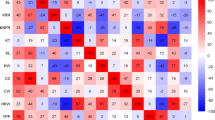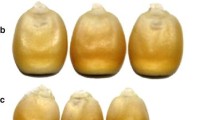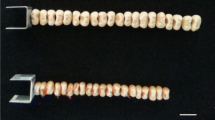Abstract
Grain yield is one of the most important and complex quantitative traits in maize breeding. In the present study, a total of 11 connected RIL populations, derived from crosses between elite inbreed “Huangzaosi” as the common parent and 11 elite inbreeds, were evaluated for five yield components and kernel-related traits under six environments. Quantitative trait loci (QTL) were detected for the traits under each environment and in joint analysis across all environments for each population. A total of 146 major QTL with R2 > 10 % in at least one environment and also detected based on joint analysis across all environments were identified in the 11 populations. Lqkwei4 conferring kernel weight and Lqklen4-1 conferring kernel length both located in the adjacent marker intervals in bin 4.05 were stably expressed in four environments and in joint analysis across six environments, with the largest R2 over 27 and 24 % in a single environment, respectively. Moreover, all major QTL detected in the 11 populations were aligned on the IBM2 2008 neighbors reference map. Totally 16 common QTL (CQTL) were detected. Seven important CQTL (CQTL1-2, CQTL1-3, CQTL4-1, CQTL4-2, CQTL4-3, CQTL4-4, and CQTL6-1) were located in bin 1.07, 1.10, 4.03, 4.05, 4.08, 4.09 and 6.01–6.02, respectively. These chromosomal regions could be targets for fine mapping and marker-assisted selection.


Similar content being viewed by others
References
Ajmone Marsan P, Gorni C, Chitto A, Redaelli R, Van Vijk R, Stam P, Motto M (2001) Identification of QTLs for grain yield and grain-related traits of maize (Zea mays L.) using an AFLP map, different testers, and cofactor analysis. Theor Appl Genet 102:230–243
Ajnone-Marsan P, Monfredini G, Ludwig W, Melchinger A, Franceschini P, Pagnotto G, Motto M (1995) In an elite cross of maize a major quantitative trait locus controls one-fourth of the genetic variation for grain yield. Theor Appl Genet 90:415–424
Austin D, Lee M (1996) Comparative mapping in F2:3 and F6:7 generations of quantitative trait loci for grain yield and yield components in maize. Theor Appl Genet 92:817–826
Austin DF, Lee M, Hallauer AR, Veldboom LR (2000) Genetic mapping in maize with hybrid progeny across testers and generations: grain yield and grain moisture. Crop Sci 40:30–39
Azanza F, Tadmor Y, Klein B, Rocheford T, Juvik J (1996) Quantitative trait loci influencing chemical and sensory characteristics of eating quality in sweet corn. Genome 39:40–50
Beavis W, Grant D, Albertsen M, Fincher R (1991) Quantitative trait loci for plant height in four maize populations and their associations with qualitative genetic loci. Theor Appl Genet 83:141–145
Brown PJ, Upadyayula N, Mahone GS, Tian F, Bradbury PJ, Myles S, Holland JB, Flint-Garcia S, McMullen MD, Buckler ES (2011) Distinct genetic architectures for male and female inflorescence traits of maize. PLoS Genet 7:e1002383
Buckler ES, Holland JB, Bradbury PJ, Acharya CB, Brown PJ, Browne C, Ersoz E, Flint-Garcia S, Garcia A, Glaubitz JC (2009) The genetic architecture of maize flowering time. Science 325:714–718
Chen DH, Ronald P (1999) A rapid DNA minipreparation method suitable for AFLP and other PCR applications. Plant Mol Biol Rep 17:53–57
Cook JP, McMullen MD, Holland JB, Tian F, Bradbury P, Ross-Ibarra J, Buckler ES, Flint-Garcia SA (2012) Genetic architecture of maize kernel composition in the nested association mapping and inbred association panels. Plant Physiol 158:824–834
Fan C, Xing Y, Mao H, Lu T, Han B, Xu C, Li X, Zhang Q (2006) GS3, a major QTL for grain length and weight and minor QTL for grain width and thickness in rice, encodes a putative transmembrane protein. Theor Appl Genet 112:1164–1171
Goldman IL, Rocheford TR, Dudley JW (1994) Molecular markers associated with maize kernel oil concentration in an Illinois high protein × Illinois low protein cross. Crop Sci 34:908–915
Gupta PK, Rustgi S, Kumar N (2006) Genetic and molecular basis of grain size and grain number and its relevance to grain productivity in higher plants. Genome 49:565–571
Hallauer AR, Miranda JB (1988) Quantitative genetics in maize breeding, 2nd edn. Iowa State University, Ames
Holland JB (2007) Genetic architecture of complex traits in plants. Curr Opin In Plant Biol 10:156–161
Lander ES, Green P, Abrahamson J, Barlow A, Daly MJ, Lincoln SE, Newberg LA, Newburg L (1987) MAPMAKER: an interactive computer package for constructing primary genetic linkage maps of experimental and natural populations. Genomics 1:174
Lee M, Austin DF (1998) Detection of quantitative trait loci for grain yield and yield components in maize across generations in stress and nonstress environments. Crop Sci 38:1296–1308
Lee M, Veldboom LR (1996) Genetic mapping of quantitative trait loci in maize in stress and nonstress environments: I. Grain yield and yield components. Crop Sci 36:1310–1319
Li Y, Wang TY (2010) Germplasm base of maize breeding in China and formation of foundation parents. J Maize Sci 18(5):1–8
Li Z, Pinson SRM, Stansel JW, Paterson AH (1998) Genetic dissection of the source-sink relationship affecting fecundity and yield in rice (Oryza sativa L.). Mol Breed 4:419–426
Li Y, Niu S, Dong Y, Cui D, Wang Y, Liu Y, Wei M (2007) Identification of trait-improving quantitative trait loci for grain yield components from a dent corn inbred line in an advanced backcross BC2F2 population and comparison with its F2:3 population in popcorn. Theor Appl Genet 115:129–140
Li Y, Li X, Li J, Fu J, Wang Y, Wei M (2009a) Dent corn genetic background influences QTL detection for grain yield and yield components in high-oil maize. Euphytica 169:273–284
Li Y, Wang Y, Shi Y, Song Y, Wand T, Li Y (2009b) Correlation analysis and QTL mapping for traits of kernel structure and yield components in maize. Sci Agric Sin 42:408–418
Li Q, Li L, Yang X, Warburton M, Bai G, Dai J, Li J, Yan J (2010) Relationship, evolutionary fate and function of two maize co-orthologs of rice GW2 associated with kernel size and weight. BMC Plant Biol 10:143
Lima MLA, de Souza CL, Bento DAV, de Souza AP, Carlini-Garcia LA (2006) Mapping QTL for grain yield and plant traits in a tropical maize population. Mol Breed 17:227–239
Lin HX, Qian HR, Zhuang JY, Lu J, Min SK, Xiong ZM, Huang N, Zheng KL (1996) RFLP mapping of QTLs for yield and related characters in rice (Oryza sativa L.). Theor Appl Genet 92:920–927
Liu XH, Tan ZB, Rong TZ (2009) Molecular mapping of a major QTL conferring resistance to SCMV based on immortal RIL population in maize. Euphytica 167:229–235
Lübberstedt T, Melchinger AE, Utz HF, Klein D, Schön CC (1997) QTL mapping in testcrosses of European flint lines of maize: I. Comparison of different testers for forage yield traits. Crop Sci 37:921–931
McMullen MD, Kresovich S, Villeda HS, Bradbury P, Li H, Sun Q, Flint-Garcia S, Thornsberry J, Acharya C, Bottoms C (2009) Genetic properties of the maize nested association mapping population. Science 325:737–740
Melchinger AE, Herrmann RG, Schön CC, Brunklaus-Jung E, Seitzer JF, Boppenmaier J (1994) RFLP mapping in maize: quantitative trait loci affecting testcross performance of elite European flint lines. Crop Sci 34:378–389
Melchinger AE, Utz HF, Schön CC (1998) Quantitative trait locus (QTL) mapping using different testers and independent population samples in maize reveals low power of QTL detection and large bias in estimates of QTL effects. Genetics 149:383–403
Melchinger AE, Mihaljevic R, Utz HF (2004) Congruency of quantitative trait loci detected for agronomic traits in testcrosses of five populations of European maize. Crop Sci 44:114–124
Messmer R, Fracheboud Y, Bänziger M, Vargas M, Stamp P, Ribaut JM (2009) Drought stress and tropical maize: QTL-by-environment interactions and stability of QTLs across environments for yield components and secondary traits. Theor Appl Genet 119:913–930
Muranty H (1996) Power of tests for quantitative trait loci detection using full-sib families in different schemes. Heredity 76:156–165
Peng B, Li Y, Wang Y, Liu C, Liu Z, Tan W, Zhang Y, Wang D, Shi Y, Sun B (2011) QTL analysis for yield components and kernel-related traits in maize across multi-environments. Theor Appl Genet 122:1305–1320
Qiao Y, Jiang W, Rahman ML, Chu SH, Piao R, Han L, Koh HJ (2008) Comparison of molecular linkage maps and QTLs for morphological traits in two reciprocal backcross populations of rice. Mol Cells 25:417
Rahman ML, Chu SH, Choi M, Li Qiao Y, Jiang W, Piao R, Khanam S, Cho Y, Jeung J, Jena KK (2007) Identification of QTLs for some agronomic traits in rice using an introgression line from Oryza minuta. Mol Cells 24:16
Revilla P, Malvar R, Ordás R, Butrón A (1999) Relationship among kernel weight, early vigor, and growth in maize. Crop Sci 39:654–658
Ribaut JM, Jiang C, Gonzalez-de-Leon D, Edmeades G, Hoisington D (1997) Identification of quantitative trait loci under drought conditions in tropical maize. 2. Yield components and marker-assisted selection strategies. Theor Appl Genet 94:887–896
Rocheford TR, Berke TG (1995) Quantitative trait loci for flowering, plant and ear height, and kernel traits in maize. Crop Sci 35:1542–1549
SAS Institute Inc. (1999) SAS user’s guide, release 8.01 edition. SAS Institute Inc., Cary
Shomura A, Izawa T, Ebana K, Ebitani T, Kanegae H, Konishi S, Yano M (2008) Deletion in a gene associated with grain size increased yields during rice domestication. Nat Genet 40:1023–1028
Smith O, Beavis W, Grant D, Fincher R (1994) Identification of quantitative trait loci using a small sample of topcrossed and F4 progeny from maize. Crop Sci 34:882–896
Song XJ, Huang W, Shi M, Zhu MZ, Lin HX (2007) A QTL for rice grain width and weight encodes a previously unknown RING-type E3 ubiquitin ligase. Nat Genet 39:623–630
Stuber CW, Lincoln SE, Wolff D, Helentjaris T, Lander E (1992) Identification of genetic factors contributing to heterosis in a hybrid from two elite maize inbred lines using molecular markers. Genetics 132:823–839
Tang J, Yan J, Ma X, Teng W, Wu W, Dai J, Dhillon BS, Melchinger AE, Li J (2010) Dissection of the genetic basis of heterosis in an elite maize hybrid by QTL mapping in an immortalized F2 population. Theor Appl Genet 120:333–340
Tian F, Bradbury PJ, Brown PJ, Hung H, Sun Q, Flint-Garcia S, Rocheford TR, McMullen MD, Holland JB, Buckler ES (2011) Genome-wide association study of leaf architecture in the maize nested association mapping population. Nat Genet 43:159–162
Utz HF (1997) PLABSTAT: a computer program for statistical analysis of plant breeding experiments. (Accessed 3Bwin of Feb 2010). Institute of Plant Breeding, Seed Science, and Population Genetics, University of Hohenheim, Stuttgart, Germany. http://www.uni-hohenheim.de/~ipspwww/soft.html
Vargas M, van Eeuwijk FA, Crossa J, Ribaut JM (2006) Mapping QTLs and QTL × environment interaction for CIMMYT maize drought stress program using factorial regression and partial least squares methods. Theor Appl Genet 112:1009–1023
Veldboom LR, Lee M (1994) Molecular-marker-facilitated studies of morphological traits in maize. II: Determination of QTLs for grain yield and yield components. Theor Appl Genet 89:451–458
Wan X, Weng J, Zhai H, Wang J, Lei C, Liu X, Guo T, Jiang L, Su N, Wan J (2008) Quantitative trait loci (QTL) analysis for rice grain width and fine mapping of an identified QTL allele gw-5 in a recombination hotspot region on chromosome 5. Genetics 179:2239–2252
Wang Y, Liu C, Wang T, Shi Y, Song Y, Li Y (2007) QTL analysis of yield components in maize under different water regimes. J Plant Genet Resour 8:179–183
Xing Y, Tan Y, Hua J, Sun X, Xu C, Zhang Q (2002) Characterization of the main effects, epistatic effects and their environmental interactions of QTLs on the genetic basis of yield traits in rice. Theor Appl Genet 105:248–257
Xu S (1998) Mapping quantitative trait loci using multiple families of line crosses. Genetics 148:517–524
Yan J, Tang H, Huang Y, Zheng Y, Li J (2006) Quantitative trait loci mapping and epistatic analysis for grain yield and yield components using molecular markers with an elite maize hybrid. Euphytica 149:121–131
Yang J, Zhu J, Williams RW (2007) Mapping the genetic architecture of complex traits in experimental populations. Bioinformatics 23:1527–1536
Zhao F, Meng X, Li W, Xu X, Wang B, Guo B (2008) Inheritance relation of maize resistant genes among foundation parent huangzaosi and its derivative lines and hybrids. J Maize Sci 16:15–18
Acknowledgments
This work was partly supported by grants provided by the Ministry of Science and Technology of China (2011CB100100, 2009CB118401), International Science and Technology Cooperation Program of China (2011DFA30450) and Natural Science Foundation of China (U1138304). We thank the help of Prof. Jiankang Wang and Dr. Huihui Li in the data analysis and of Dr. Bailin Li for technique advice.
Author information
Authors and Affiliations
Corresponding authors
Additional information
Y. Li—Co-author, equally contribute to the work
Electronic supplementary material
Below is the link to the electronic supplementary material.
Rights and permissions
About this article
Cite this article
Li, C., Li, Y., Sun, B. et al. Quantitative trait loci mapping for yield components and kernel-related traits in multiple connected RIL populations in maize. Euphytica 193, 303–316 (2013). https://doi.org/10.1007/s10681-013-0901-7
Received:
Accepted:
Published:
Issue Date:
DOI: https://doi.org/10.1007/s10681-013-0901-7




